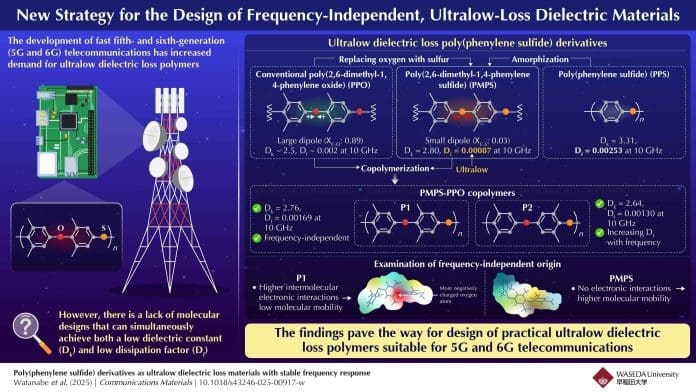
Scientists at Waseda University have created a new class of polymers with ultralow dielectric loss that could enable future high speed telecommunications networks beyond 5G. The breakthrough, published in August 2025 in the journal Communications Materials, addresses a critical materials challenge as the world moves toward sixth generation wireless technology.
The problem sounds technical, but it matters for everyone who’ll eventually use 6G networks. As telecommunications expand into 5G and 6G frequencies, the demand for polymer based dielectrics with both a low dielectric constant and low dissipation factor is rising sharply. These insulating materials guide electromagnetic signals with minimal loss, but achieving both properties simultaneously has proven difficult.
Professor Kenichi Oyaizu from Waseda University’s Department of Applied Chemistry led the research team that cracked this challenge. Their strategy was elegantly simple: replace oxygen atoms with sulfur in certain polymers. “Based on our previous research on high refractive index polymers, we hypothesized that replacing oxygen with sulfur in certain polymers could significantly reduce the dissipation factor,” Oyaizu explained.
The team started with poly(2,6 dimethyl 1,4 phenylene oxide), known as PPO, which currently offers the best balance of low dielectric constant and dissipation factor. By swapping oxygen for sulfur, they created poly(2,6 dimethyl 1,4 phenylene sulfide), or PMPS, a derivative of poly(phenylene sulfide).
The results exceeded expectations. PMPS achieved a dielectric constant of 2.80 and an ultralow dissipation factor of 0.00087 at 10 gigahertz (GHz), significantly better than PPO. This improvement stems from sulfur’s higher polarizability and smaller dipole moment compared to oxygen, meaning less energy gets lost as signals pass through the material.
The researchers didn’t stop there. They synthesized two copolymers mixing sulfur and oxygen in alternating sequences, labeled P1 and P2. P1 showed a dielectric constant of 2.76 and dissipation factor of 0.00169, while P2 demonstrated values of 2.64 and 0.00130 respectively. The pattern was clear: increasing sulfur content reduces dissipation factor.
Testing across frequencies from 10 to 80 GHz revealed something particularly interesting about P1. While dielectric constants remained stable across all polymers, dissipation factors increased with frequency for PPO, PMPS, and P2. P1 bucked this trend, maintaining an almost constant dissipation factor and achieving the lowest value among all polymers at 80 GHz.
The explanation involves molecular behavior. The alternating sulfur oxygen sequence in P1 and P2 creates increased intermolecular interactions that reduce molecular mobility. P1 specifically has higher resistance to molecular rotation, which combined with reduced motion between molecules results in a near constant dissipation factor across wide frequency ranges. Strong thermal stability makes P1 particularly practical for future high frequency telecommunications applications.
Why does this matter beyond laboratory specifications? The low loss materials market for 5G is forecast to grow from 1.2 billion dollars in 2024 to 3.5 billion dollars by 2033, reflecting a compound annual growth rate of 15.2%. That market expansion reflects the technical challenges involved in transmitting signals at frequencies ranging from tens to hundreds of gigahertz, where signals become highly sensitive to transmission loss, interference, and distortion.
Fifth generation networks already operate at these demanding frequencies. Sixth generation networks, expected later this decade, will push requirements even further. The global 5G infrastructure market was estimated at 16.69 billion dollars in 2023 and is projected to reach 95.88 billion dollars by 2030, creating enormous demand for materials that can handle these frequencies efficiently.
Current industry standard materials include polytetrafluoroethylene (PTFE) and reinforced epoxy thermosets. These work for existing applications but may not meet the more stringent requirements of 6G networks. Researchers worldwide are exploring novel structures and modifiers to push performance boundaries, though precise targets for 6G remain under discussion.
Oyaizu’s team built on his extensive background in polymer chemistry. He obtained his doctorate from Waseda University in 1995 and has since published approximately 300 papers focusing on polymers for electron transfer based organic electronics and energy storage devices. His work has earned recognition including the Chemical Society of Japan Award for Young Chemists in 2002.
Junior researcher Seigo Watanabe of Waseda University contributed significantly to the study, along with colleagues Shuma Miura, Tomohiro Miura, Yoshino Tsunekawa from Waseda’s Applied Chemistry department, and Daisuke Ito from Daicel Corporation.
The practical implications extend beyond just better phone signals. High frequency telecommunications underpin everything from autonomous vehicles to remote surgery to industrial automation. Materials that reduce signal loss translate directly into more reliable connections, longer transmission distances, and lower power consumption.
Oyaizu emphasized that this represents just a starting point. “Our study presents a breakthrough concept of replacing oxygen with sulfur for the design of ultralow dielectric polymers. We believe this is a first step toward practical materials that can power telecommunications beyond 5G.”
The road from laboratory discovery to commercial deployment involves additional steps. Materials need to prove themselves in manufacturing environments, demonstrate long term stability under real world conditions, and integrate into existing production processes. Cost effectiveness matters too, though performance advantages often justify premium pricing for critical telecommunications components.
What makes this research particularly promising is its foundation in well understood polymer chemistry. The team isn’t proposing exotic materials requiring entirely new manufacturing processes. They’re modifying existing polymer families in ways that could potentially scale to industrial production relatively quickly compared to more radical material innovations.
Waseda University, located in Tokyo’s heart, has pursued academic excellence and innovative research since 1882. The institution has set a target of achieving zero carbon campus operations by 2032, aligning with United Nations Sustainable Development Goals adopted in 2015. Its Department of Applied Chemistry dates back nearly a century, conducting research aimed at developing chemistry capable of producing highly functional materials and innovative fabrication processes.
For telecommunications engineers and network planners watching 6G development, Oyaizu’s sulfur substitution strategy offers a concrete pathway toward materials that can meet increasingly demanding specifications. Whether P1 or related polymers become industry standards remains to be seen, but the research demonstrates that fundamental chemistry innovations can still address cutting edge technological challenges.
Source: newsghana.com.gh










